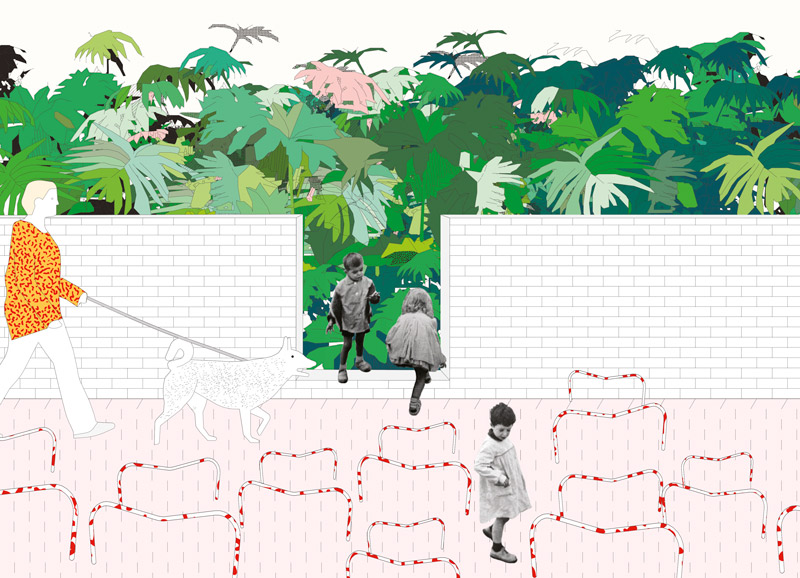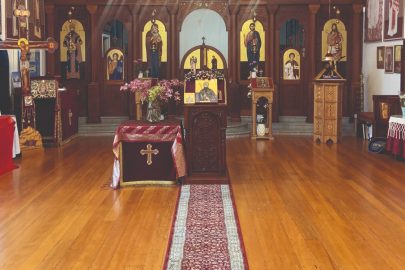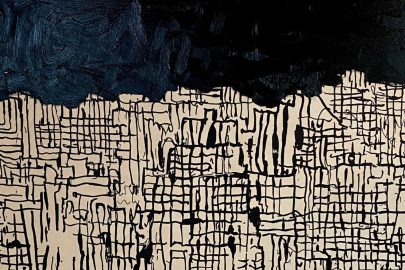Mar 3, 2014 Urban design
Forget the official plans for Wynyard Point: how about a really radical approach?
“The Island” — two stonking artificial volcanic cones sitting about 100m off the tip of Wynyard Point and accessed, at very low tides, by something called “The Teeth of Boredom”. It’s the “iconic” aspect of Frances Cooper’s grand design for the land known as Tank Farm.
Iconic and ironic. The 24-year-old Auckland School of Architecture masters graduate is ardently against the city’s obsession with the iconic. “It was a huge issue for me that I’m anti-iconic, but at the end of the day I still give Auckland an island, which is iconic in its own right,” she admits.
Cooper, whose surreal seascape has won her Architectural Review’s prestigious Global Architecture Graduate Award, is quick to point out that her prime design intention — to make the space “incredibly public” — holds true. Indeed it does. As well as The Island, Cooper gives us a glorious public playground comprising a downtown beach replete with a quirky array of flotation devices for our aquatic amusement; a barge convoy — “a kind of sushi train of different grounds running in and out with the tides”; plus a walled arcade garden, restaurant, trams and more.
She names her architecture with flair and humour: Rousseau’s Jungle — “to suggest an exotic condition” as opposed to the more mundane “bush”; the Buoyant Dial Lounger — “for reclining, half in and half out of the water”; and the Copacabana Oyster Seats collaged with “the succulent pink gills” of the Pink Oyster Mushroom. These form parts of Cooper’s “Armada of Amusement”, a leisurescape animating the “frivolity and fervent publicness” of beach with “new surfaces of performance” — such as the Ha-Ha and Hide and Seek barges.
Spectacular, yes. Also synthetic — the island and the beach with its buoyant grounds are artificial, as is the reclaimed land of the whole area. And belligerent — the land is terribly contaminated by its years of storing petroleum products and Cooper deals with the persistent unpleasantness by scooping up the contaminated soil and sealing it under the concrete carapace of the island. The three words feature in the title of her thesis: Architecture of the synthetic, the spectacular and the belligerent: constructing Wynyard Island and its urban littoral.
Thanks to the award, which Cooper won in the post-graduate category ahead of 500 entries from around the world, many, including Waterfront Auckland, are now asking her to explain more of her vision.
When we talk, she is still somewhat bewildered by her success and preparing to do a workshop with Waterfront Auckland about her scheme. One imagines a fascinating face-off because Cooper’s thesis is largely a critique of the Waterfront Auckland Plan — especially its earmarking of the tip of the Wynyard peninsula for a “significant public building”, a proposition Cooper sees as fundamentally flawed because iconic architecture shouldn’t just be ordered up.
“Indeed, the agenda of the iconic building is a post-political architecture stripped bare of any meaning other than the celebration of corporate economic performance,” she writes sternly. A celebration that’s vividly visible in SkyCity casino’s Sky Tower, arguably the current icon of Auckland’s skyline. Then there was the Rugby World Cup mania for an iconic stadium on the waterfront, followed by a competition for the development of Queens Wharf — a fiasco that resulted in “The Cloud”, an icon of spectacular banality.
Of course, this obsession with the iconic can be laid at the feet of Frank Gehry and the so-called “Bilbao effect”: the thought that with the right architect, such a spectacle of capital will drive a corporate revival of the city.

Entrance to Rousseau’s Jungle: A space intended to evoke a nostalgic reverie, lamenting the loss of a time when children had a formal place in the city.
Rather than creating a Guggenheim Museum or a Sydney Opera House, Cooper’s beach park addresses the tragedy of Auckland’s waterfront — its vast reclamation, privatisation and exclusion of the public. In scraping out the contaminated soil, she creates fingers of public Queen’s Chain land on the point and lets the sea’s ebb and flow return. The problem with Waterfront Auckland’s proposal for her was that “the sea participated, but was kept at bay”, seemingly only to look at. “For me, the spectacular is enacted by water,” says Cooper. “There is an opportunity for more engagement with the sea’s receding and shrinking elastic edge.”
The scheme also confronts land that isn’t real land and Auckland’s habit of moving soil around to appropriate, since 1859, some 97ha of Waitemata foreshore and seabed. Then there’s the quarrying of various volcanic cones such as Puketutu Island, now to be filled with bio-solids from Watercare’s Mangere sewage treatment plant.
Tank Farm soils, which include foundation excavations from Queen St, have long since been polluted by its oil and petroleum multinational tenants. Determined not to have the contamination end up as landfill somewhere else, Cooper’s remediation is The Island, modelled on the two lost cones of the Three Kings volcanoes quarried away during the 1930s and 40s. The soil, forever entombed in its concrete bunker, becomes a “monument to our consumptive existence”.
Will it ever see the light of day? “I struggle quite a lot to get people to take me seriously — that is my frustration,” says Cooper. Those who have suggested her design is too whimsical have met a steely resolve. “Mostly critics catch on fairly quick — that the work is serious and so am I.”
As a new graduate working in a male- dominated profession, has she encountered sexism? “I choose not to recognise it, even if it is there,” she says implacably. She prefers to think the glass ceiling doesn’t exist. “That might be incredibly naive,” she says, but so far the “just ignore it — it’s not there” attitude seems to be working for her. “It’s as though in acknowledging its existence, one almost perpetuates a personal need to respond to it.”
The Gantry at Silo Park offers the wonderful, pure folly of a high public footpath to nowhere amid a surreal landscape of cylindrical towers — a clear sign that Waterfront Auckland understands what a mad and brilliant family playground Wynyard Point could be. Now it needs to put Cooper in charge.





